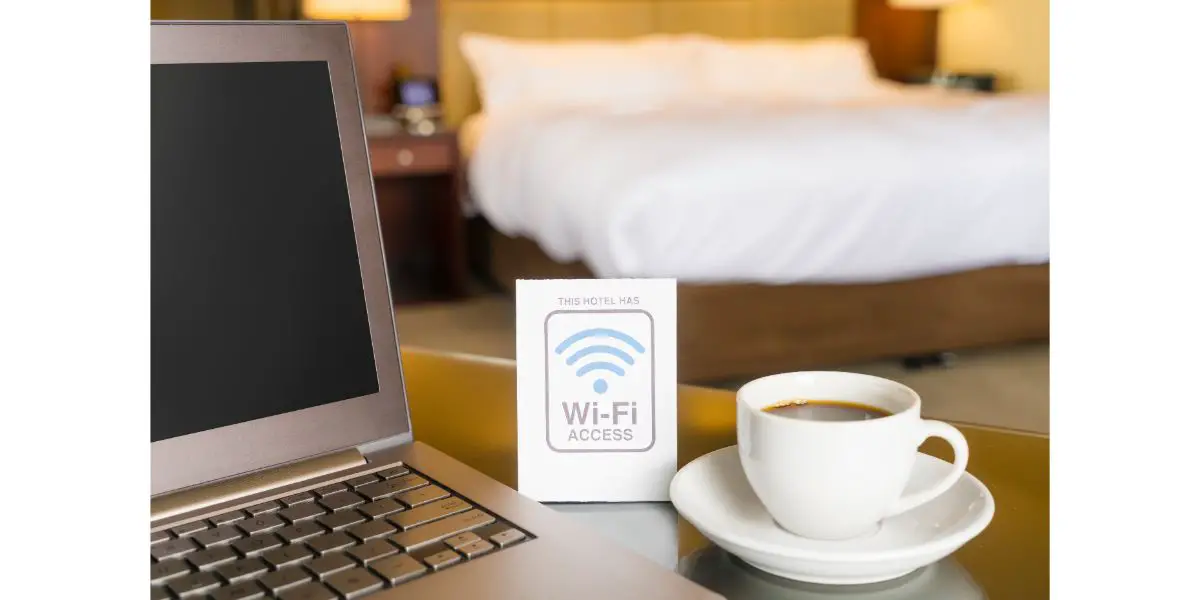Disclaimer: This post may contain affiliate links, meaning we get a small commission if you make a purchase through our links, at no cost to you. For more information, please visit our Disclaimer Page.
Whether you are traveling for business or leisure, you may find it necessary to hook your laptop up to your hotel’s Wi-Fi. You may need to get work done, or you may have the desire to get connected for all your relaxation needs.
However, you may run across the issue where your laptop will not connect to your hotel’s Wi-Fi network, and here are some reasons why this may happen and some ways to fix it.
Table of Contents
What Factors Can Affect Connectivity?
Network servers establish connections, authenticate logins and passwords, and set up IP addresses so your laptop can communicate with the network and make its presence known. These are some of the primary determinants affecting your laptop’s ability to surf the web.
The Web Browser You Are Using
Web browsers have varying configuration settings when it comes to establishing a connection to a network. Google Chrome, Mozilla Firefox, and Safari interpret DNS and cache settings differently and will respond accordingly, and this may deter your browsing preferences from happening as you want them to.
The Status of Your Laptop
Your laptop can potentially have system or internal errors that can prevent you from connecting to any network. For these issues, you can to troubleshoot them using online guides or having a technician service your laptop for severe issues.
The Current Condition of the Hotel’s Wi-Fi Network
Your laptop may not be the problem at all. The hotel where you are staying may be overloaded with many devices trying to use the network simultaneously, which can prevent you from joining the network. Alternatively, the Wi-Fi may be down and completely inaccessible to all the hotel’s guests.
Your Laptop’s Existing Networking Settings
You may have previously existing network configurations that you used to access the internet at other places, including your home. An alternative DNS can prevent your laptop from successfully securing a connection to a hotel’s Wi-Fi.
What Are Some Reasons Laptop is Not Connecting to Your Hotel’s Wi-Fi?
There are multiple reasons why your laptop may not be able to connect to your hotel’s Wi-Fi so that you can perform your online tasks. There are a few ways in which your laptop may demonstrate that it cannot get connected:
1. When you open your laptop to show available Wi-Fi networks, the hotel’s Wi-Fi does not appear in the list.
2. Your laptop says it is connected to the network, but you do not have internet access.
3. The Wi-Fi login authentication failed when you attempted to access the hotel’s Wi-Fi.
Regardless of how your laptop demonstrates the issue, these are a few reasons it may behave that way.
1. Your Laptop’s Wi-Fi Switch Is Turned Off
This is the simplest of reasons as to why you would not be able to connect to a Wi-Fi network. You may have temporarily switched off your laptop’s Wi-Fi, or you may have put your laptop in airplane mode to remove all wireless communications.
2. Connection to a Public Network
Because a hotel’s Wi-Fi network connection is public, your laptop’s firewall may be indicating that the hotel’s Wi-Fi is not safe and will refuse to connect. You may see this in a pop-up that appears when you first attempt to connect to the network.
6 Fixes to Get Online
When your web browser greets you with a “Cannot establish a connection to this page” or your laptop asserts that it is connected to your hotel’s Wi-Fi but acts otherwise, it is frustrating, but luckily, there are available solutions that you can try to get connected to the network.
1. Reboot Your Laptop
As a fallback plan, you can restart your laptop to reset any broken files or configurations preventing you from connecting to a network.
2. Allow Pop-Ups
Because pop-ups can be intrusive to your personal data and lead you to potentially harmful websites, your web browser may block them by default.
However, a pop-up setting may be the thing you need to change to get to your hotel Wi-Fi’s authentication page. The steps to enable pop-ups vary by web browser, but here is a general approach to the task:
- Click on the hamburger menu or three little dots in the top-right corner of your browser window.
- Select “Settings” from the menu.
- Choose the tab that says “Privacy and Security” or something similar, and scroll down until you see something like “Block pop-up windows” amongst other security options.
- Enable pop-ups by unchecking the checkbox if it is not already unchecked.
- Try connecting to your hotel’s Wi-Fi again now that you have enabled pop-ups.
3. Ensure You Have the Login Details Correct
The hotel service desk may be responsible for handing you Wi-Fi connection data when you check-in, or you may find it in a booklet in your hotel room.
In either case, ensure you read and input the login information correctly when connecting to the Wi-Fi. If you are entering all the right details but getting error messages, check with the front desk in case the connection detail are outdated.
4. Enable Wi-Fi Connections
Turn on your laptop’s Wi-Fi switch and ensure airplane mode is off. In this way, you should be able to guarantee your hotel’s Wi-Fi network name shows up in the list of all available networks. You can additionally temporarily disable your firewall to allow access to the network.
5. Change DNS Settings
If you are using custom DNS settings to access the web, it may be incompatible with the network. In this case, you will need to change your laptop’s network adapter settings so that it obtains a DNS server automatically.
You can do this either by typing in ipconfig /flushdns in Command Prompt or going into the network’s settings and selecting “Obtaining DNS server address automatically” in the IPv4 properties.
After changing your DNS settings, you can obtain an IP address to get to the hotel’s login page. To get there:
- Click the Wi-Fi icon in your taskbar.
- Select “Properties” for the appropriate Wi-Fi network.
- Scroll down until you see the IPv4 address: copy this address into your browser’s URL bar, and you should see the network’s terms of service page.
6. Go Incognito
Private mode ensures that there is no cache or browsing history left behind. You can use it to have secure access to the network.
Conclusion
Seeing many possibilities and reasons as to why your laptop will not connect to hotel Wi-Fi is the first step in resolving a connection issue. Any of these solutions can help you to get online.


